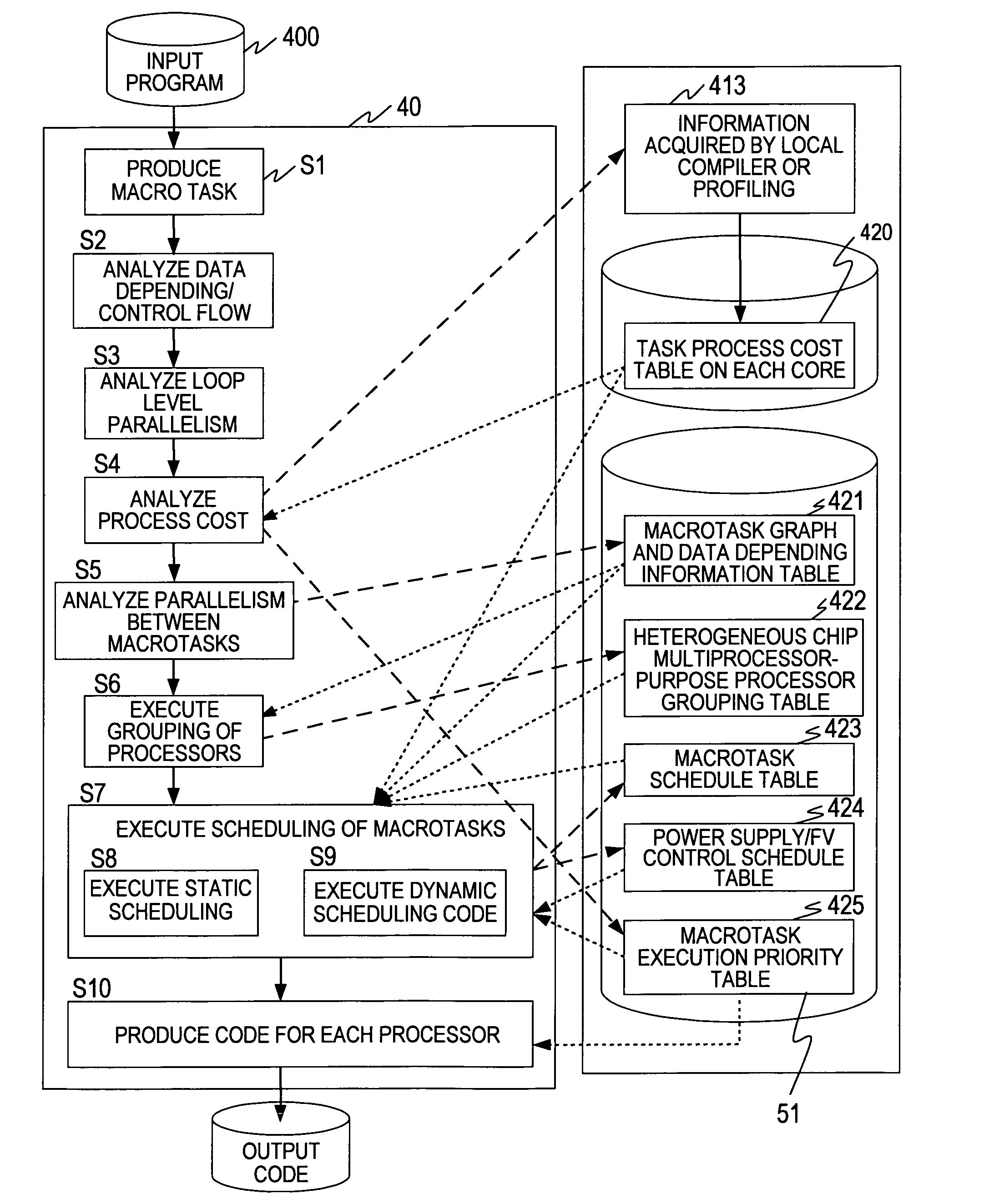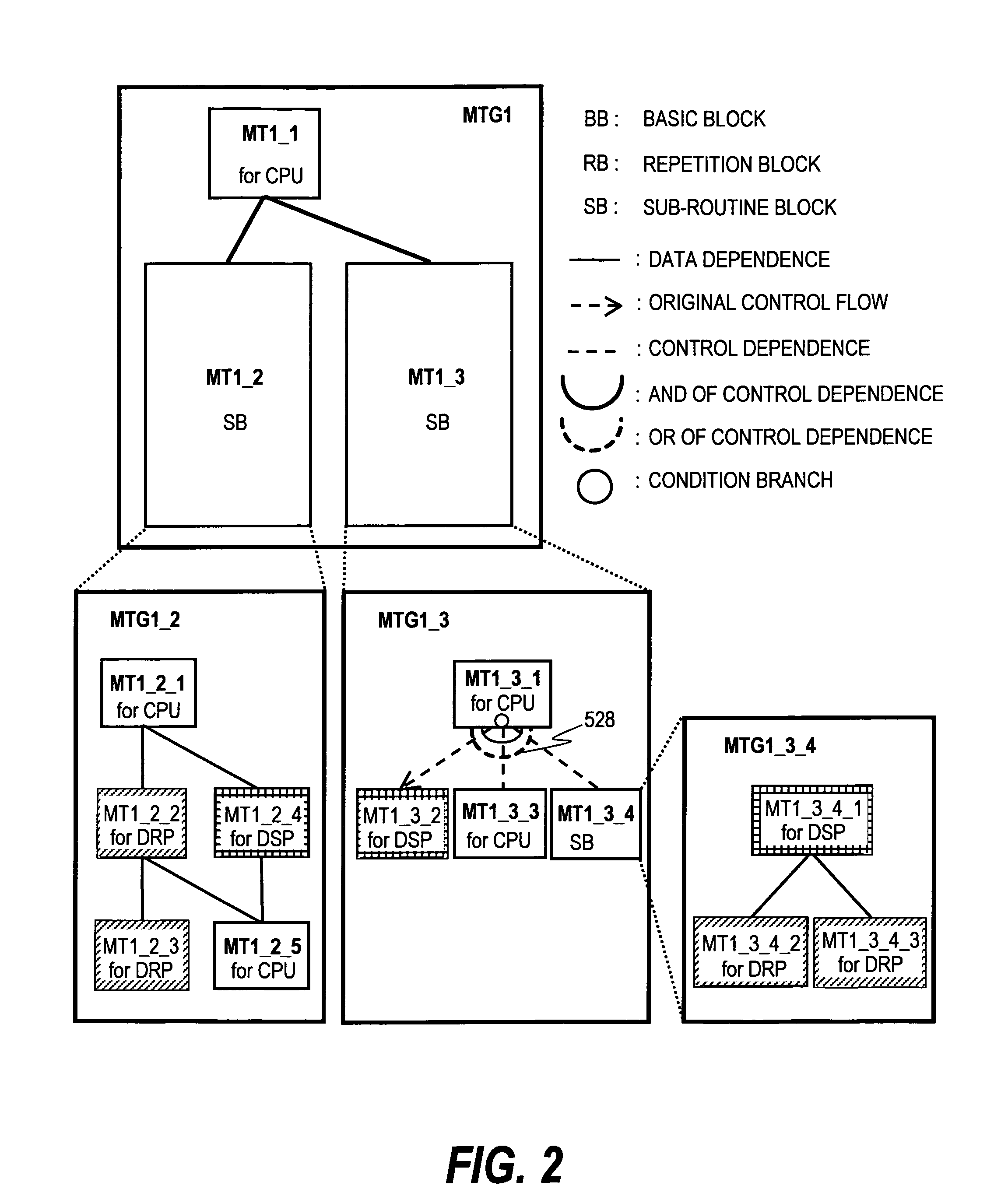Method for controlling heterogeneous multiprocessor and multigrain parallelizing compiler
a multi-processor, compiler technology, applied in multi-programming arrangements, instruments, sustainable buildings, etc., can solve the problems of inability to conduct the performance of this system, shortening the resources of the system, and ineffective parallelization of tasks, so as to achieve the effect of reducing overhead, reducing the number of overhead, and improving efficiency
- Summary
- Abstract
- Description
- Claims
- Application Information
AI Technical Summary
Benefits of technology
Problems solved by technology
Method used
Image
Examples
first embodiment
(Entire Arrangement of First Embodiment)
[0037]FIG. 1 schematically shows an arrangement of a multiprocessor system according to a first embodiment of this invention. In FIG. 1, a heterogeneous multiprocessor system 1 is mainly composed of processor elements (hereinafter, referred to as “PE”) 10 to 17 whose instruction sets and configurations are different from each other; a centralized shared memory (hereinafter, referred to as “CSM”) 18 which is shared by these PEs 10 to 17; and an internal network 19 which connects the respective PEs 10 to 17 to the CSM 18. It should be noted that the internal network 19 may be alternatively arranged by employing a shared bus, a cross bus, or the like.
[0038]The respective PEs 10 to 17 and the CSM 18 are connected via respective interfaces (not shown) to the internal network 19.
[0039]As to a sort and a total number of these PEs, the first embodiment shows an example where the heterogeneous multiprocessor system 1 is composed of four general-purpose...
second embodiment
(Second Embodiment)
[0218]FIGS. 13, 14, and 17 show a second embodiment of this invention, and exemplify an example where a distributed / centralized dynamic scheduling processing is applied. In this dynamic scheduling processing, a dynamic scheduling code thereof is mainly processed by a single general-purpose PE. In this second embodiment, the general-purpose PE which executes the scheduling code is statically described, and other configurations thereof are similar to those of the above-mentioned first embodiment.
[0219]FIG. 13 shows an example of a macro task graph which is entered as the input program 400′, in the compiler 40 to be produced.
[0220]As a result of analyzing the input program 400′ by the compiler 40, as shown in FIG. 13, the macro task graph MTG1 of the input program 400′ is divided into two macro tasks MT1_1 and MT1_2 in such a manner that these macro tasks MT1_1 and MT1_2 are sequentially processed. It should be noted that representations in this drawing are similar t...
third embodiment
(Third Embodiment)
[0248]FIG. 15 indicates a processor system according to a third embodiment of this invention, in which an execution queue of the accelerator group according to the first embodiment is set for each of the specific-purpose PEs, and other configurations thereof are made similar to those of the first embodiment.
[0249]In FIG. 8 of the first embodiment, such an example has been described that while a group is set for each sort of the specific-purpose PEs of the accelerator group, one execution queue is set with respect to each of these groups. Alternatively, as shown in FIG. 15, an execution queue may be provided every specific-purpose PE of the accelerator group.
[0250]In other words, the accelerator group may constitute a DSP group DSPG and a DRP group DRPG every sort of the specific-purpose PE. Execution queues ECDS0 and ECDS1 may be provided within the DSP group DSPG with respect to a distributed shared memory 23 of each of the DSP0 and the DSP1. Execution queues ECDR...
PUM
 Login to View More
Login to View More Abstract
Description
Claims
Application Information
 Login to View More
Login to View More - R&D
- Intellectual Property
- Life Sciences
- Materials
- Tech Scout
- Unparalleled Data Quality
- Higher Quality Content
- 60% Fewer Hallucinations
Browse by: Latest US Patents, China's latest patents, Technical Efficacy Thesaurus, Application Domain, Technology Topic, Popular Technical Reports.
© 2025 PatSnap. All rights reserved.Legal|Privacy policy|Modern Slavery Act Transparency Statement|Sitemap|About US| Contact US: help@patsnap.com



